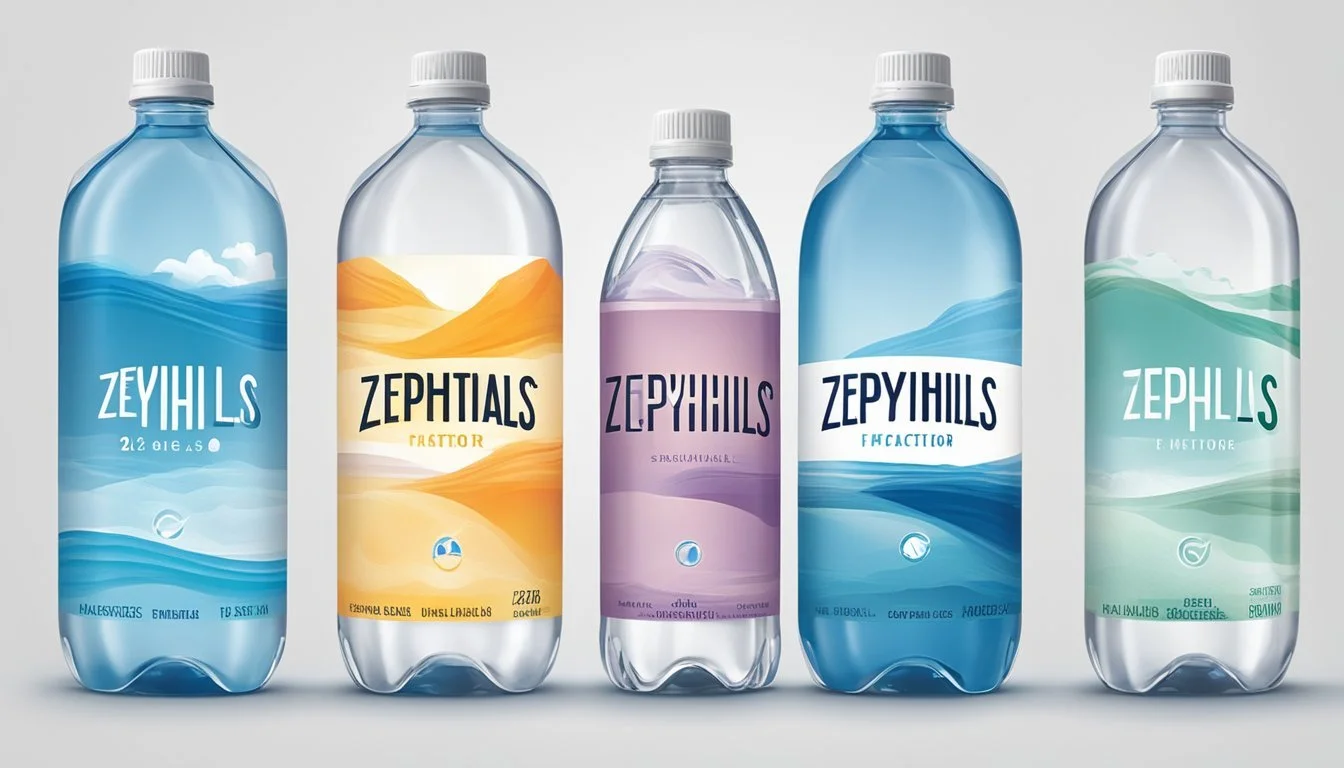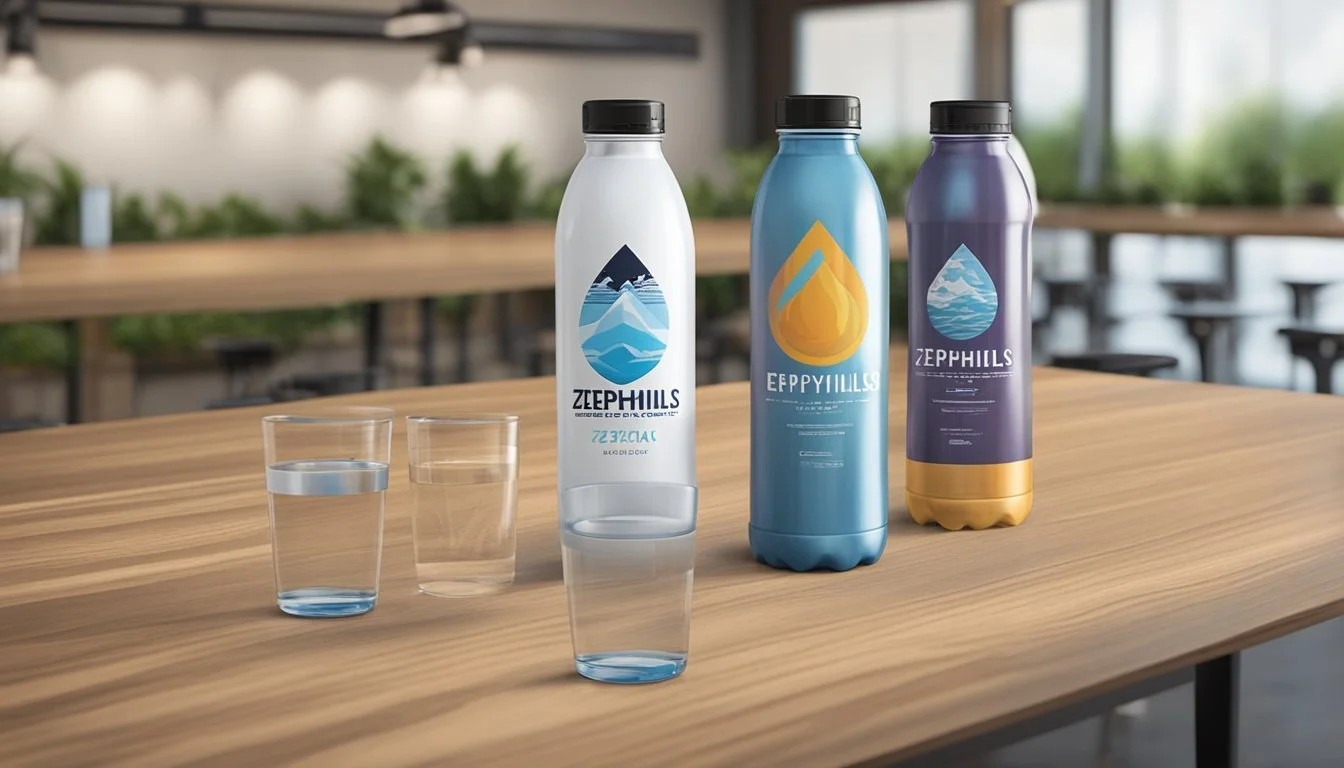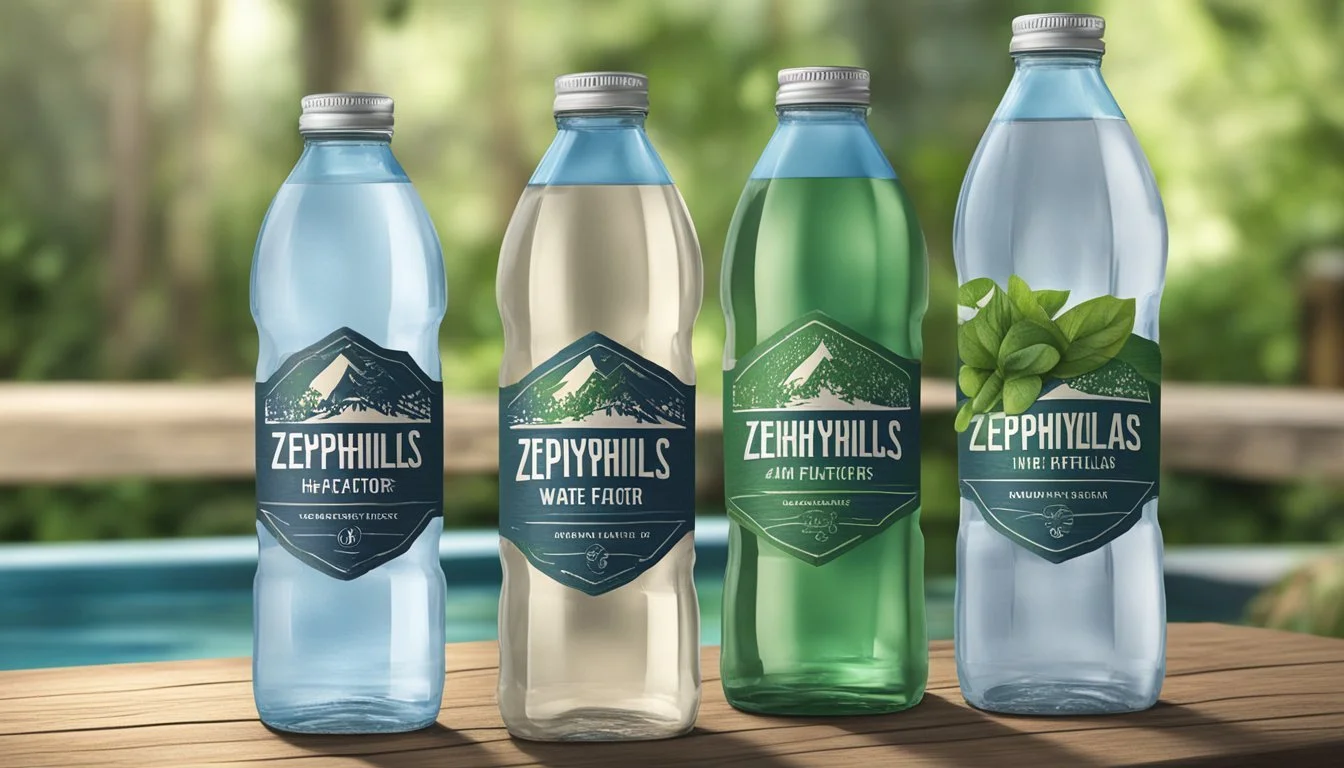Zephyrhills vs. HFactor
Comparing Top Bottled Waters
When it comes to deciding between Zephyrhills and HFactor bottled water, consumers often weigh various factors such as taste, health benefits, and sourcing. Zephyrhills water, sourced from natural springs in Florida, boasts a rigorous purification process and contains essential minerals like calcium, magnesium, and potassium. This ensures a refreshing taste and potential health benefits, making it a reliable choice for everyday hydration.
HFactor, on the other hand, offers a unique proposition with its hydrogen-infused water, promising enhanced athletic performance and reduced inflammation. This cutting-edge approach appeals to those looking for more than just hydration, but also additional health benefits from their bottled water. Zephyrhills excels in purity and mineral content, while HFactor leads with innovation and potential health perks.
Choosing between Zephyrhills and HFactor ultimately depends on individual preferences and needs. For those prioritizing pure, mineral-rich water from a trusted natural source, Zephyrhills is an excellent option. Conversely, HFactor targets fitness enthusiasts and health-conscious individuals seeking advanced hydration solutions. This guide will delve deeper into the characteristics, benefits, and potential drawbacks of each brand to help you make an informed decision.
Understanding Bottled Water
Bottled water has seen significant evolution, with various types emerging to meet different consumer preferences. Understanding its history, categories, and regulatory standards can offer clarity on this essential commodity.
History and Evolution of Bottled Water
Bottled water's history dates back centuries. Originally marketed for therapeutic benefits, it gained popularity in the 19th century as a luxury item. By the late 20th century, bottled water evolved into a convenient and essential product. The rise in health consciousness and the desire for portable drinking options fueled this transformation. Today, brands like Zephyrhills and HFactor are part of a vast industry offering diverse water types.
Categories of Bottled Water
Spring Water: Sourced from natural springs, it contains natural minerals. Zephyrhills is an example, offering water with a straightforward mineral composition.
Purified Water: Treated to remove impurities, it undergoes processes like distillation or reverse osmosis. HFactor may include such water types, emphasizing purity and quality.
Mineral Water: Must contain specific levels of minerals like calcium and magnesium, and is often marketed for its health benefits.
Different categories cater to various consumer needs, from the mineral-rich appeal of spring waters to the clean, refined taste of purified varieties.
Regulatory Bodies and Quality Standards
The Food and Drug Administration (FDA) regulates bottled water as a packaged food product. This includes ensuring proper labeling and adherence to specific safety standards. Meanwhile, the Environmental Protection Agency (EPA) regulates tap water, setting standards that bottled water must meet or exceed.
These regulations ensure that bottled water, whether it is spring, purified, or mineral, remains safe for consumption. Brands like Zephyrhills and HFactor must comply with these standards to guarantee quality and safety to their consumers.
Profile: Zephyrhills
Zephyrhills, a renowned bottled water brand, draws its natural spring water from selected springs in Florida. It emphasizes natural filtration and sustainability, crucial for eco-conscious consumers.
Source and Origin
Zephyrhills sources its water from natural springs in Florida. The state is known for its abundant freshwater springs, making it an ideal location for high-quality bottled water. Specific springs in use include Crystal Springs, Bear Gully Springs, and Cypress Springs. The natural spring water is collected directly at the source, capturing the natural purity and mineral content that gives Zephyrhills its refreshing taste.
Filtration and Purification Processes
Zephyrhills utilizes a natural filtration process that the underground springs provide. This process involves layers of sand and gravel that naturally filter the water. After collection, the water undergoes minimal additional filtration to ensure it maintains its natural properties. The goal is to preserve the water's original mineral content and taste, delivering a product that is both clean and refreshingly natural.
Environmental Commitments
Zephyrhills is committed to reducing its environmental footprint. The brand prioritizes sustainability by using recyclable plastic for its bottles and reducing the amount of plastic used in production. They also focus on source preservation, ensuring the springs are maintained responsibly. Zephyrhills contributes to local conservation efforts and works to improve water conservation practices in Florida. Their commitment reflects a broader industry push towards more sustainable and eco-friendly bottled water production.
Profile: HFactor
HFactor is a distinctive bottled water brand known for its hydrogen-infused water and innovative approach to hydration. This section explores the technology behind HFactor, its health benefits, and its packaging.
Technology and Innovation
HFactor employs a unique technology to infuse water with hydrogen. Utilizing reverse osmosis and a proprietary method, HFactor ensures that hydrogen molecules are effectively dissolved in the water, delivering its benefits without altering the taste or purity. The process is designed to maintain the optimal concentration of hydrogen, aiming for maximum hydration and efficacy.
The company's innovative techniques set it apart from traditional water brands, focusing on the scientific enhancement of water to promote better health outcomes.
Health Benefits of Hydrogen Infusion
Hydrogen-infused water is believed to offer several health benefits. Studies suggest that it may help reduce inflammation, improve athletic performance, and enhance overall wellness. The antioxidant properties of hydrogen are said to combat oxidative stress, which can contribute to various health issues.
While research is ongoing, many users report feeling more hydrated and experiencing increased energy levels after consuming HFactor. Making it a popular choice for those looking to improve their fitness and health routines.
Packaging and Environmental Responsibility
HFactor is committed to environmentally responsible packaging. The bottled water comes in recyclable aluminum pouches, which are both lightweight and environmentally friendly. This approach not only reduces plastic waste but also ensures that the packaging itself has a lower carbon footprint.
The brand emphasizes sustainability, encouraging consumers to recycle the pouches after use. HFactor's dedication to eco-friendly practices reflects a broader trend in the bottled water industry toward more sustainable and responsible packaging solutions.
Taste Test: Zephyrhills and HFactor
Zephyrhills and HFactor are popular bottled water brands that offer distinct taste experiences. This section explores flavor profiles, consumer preferences, and expert opinions to provide a comprehensive comparison.
Flavor Profiles
Zephyrhills water comes from natural springs, giving it a crisp and refreshing taste. The naturally occurring minerals such as calcium, magnesium, and potassium contribute to its unique flavor. These minerals not only enhance the taste but also provide health benefits.
HFactor water is infused with molecular hydrogen, which is marketed to offer several health benefits. The taste of HFactor tends to be clean and smooth, with a less noticeable mineral flavor compared to Zephyrhills. The absence of strong mineral taste makes it refreshing to some consumers.
Consumer Preferences
Many people have distinct preferences when it comes to the taste of bottled water. Zephyrhills is often favored by those who enjoy a rich mineral presence in their water. The natural spring source is a key factor for these consumers.
On the other hand, HFactor attracts those looking for a pure, clean-tasting water without the pronounced mineral flavors. Consumers who prefer HFactor appreciate the smoothness and potential health benefits due to its hydrogen infusion.
Expert Opinions
Experts acknowledge that both Zephyrhills and HFactor provide high-quality water but highlight contrasting qualities. Hydrologists note the natural mineral content of Zephyrhills, emphasizing its taste appeal and potential health benefits.
Nutritionists suggest that HFactor’s molecular hydrogen could offer unique health advantages and appreciate its pure taste profile. They also note the absence of additional minerals, catering to those who prefer a straightforward water flavor.
In summary, the differences in taste and mineral content between Zephyrhills and HFactor cater to diverse consumer preferences, with both boasting distinct advantages in their flavor profiles and potential health benefits.
Comparative Analysis
Zephyrhills and HFactor offer distinct advantages regarding mineral content, purity, and convenience. This comparative analysis dives into these aspects to provide a comprehensive understanding of the two bottled water brands.
Mineral Content and Health Implications
Zephyrhills is sourced from natural springs in Florida, imparting a rich mineral profile that includes calcium, magnesium, and sodium. These minerals contribute to electrolyte balance and support cardiovascular health.
HFactor, on the other hand, prides itself on its unique hydrogen-infused formulation. This process is claimed to enhance athletic performance and improve recovery times. The health implications of hydrogen water are still under study, but preliminary research suggests potential antioxidant benefits.
Zephyrhills' natural mineral content may be preferable for individuals seeking consistent mineral intake. In contrast, those interested in cutting-edge hydration technologies might gravitate towards HFactor for its innovative approach.
Purity and Presence of Contaminants
Zephyrhills undergoes rigorous safety and quality control measures to ensure its purity. As a spring water, it is naturally filtered through geological formations, which helps in maintaining low levels of contaminants.
HFactor also emphasizes purity, employing a specialized hydrogenation process. Each batch of water is tested to confirm the absence of harmful contaminants. This extensive purification ensures a clean drinking experience.
Both brands adhere to stringent standards, but Zephyrhills benefits from its natural filtration while HFactor relies on advanced processing techniques. Choosing between them may depend on personal preference for natural versus technologically enhanced purity.
Convenience and Accessibility
Zephyrhills is widely available in various retail outlets across the United States. Its broad distribution network makes it an accessible choice for consumers seeking a reliable source of hydration.
HFactor, marketed as a niche product, is often found in specialty health stores and online platforms. The packaging is designed for convenience, offering single-serve pouches that are easy to carry and store.
Zephyrhills stands out for its widespread availability, appealing to consumers looking for an everyday solution. HFactor, though less ubiquitous, attracts those interested in innovative hydration solutions and specialty products.
Environmental Considerations
This section examines the environmental impact of Zephyrhills and HFactor bottled water, focusing on bottling and distribution impact, packaging materials, waste management, and carbon footprint.
Bottling and Distribution Impact
The production and distribution of bottled water affect the environment significantly. Zephyrhills sources water from natural springs in Florida, raising concerns about local water tables and ecosystems. HFactor uses a specialized hydrogen-infused water, necessitating additional processing steps.
Distribution is another critical factor; Zephyrhills' reliance on traditional logistics methods results in higher greenhouse gas emissions. HFactor’s unique product often demands specialized transportation, potentially increasing its carbon footprint. Both brands need to balance water quality and environmental sustainability.
Packaging Materials and Waste Management
Packaging materials play a crucial role in sustainability. Zephyrhills primarily uses plastic bottles, which raises issues of plastic waste and BPA concerns. Their packaging is not predominantly recyclable, contributing to the global plastic waste problem.
HFactor, on the other hand, offers water in aluminum pouches, a more sustainable option. Aluminum is generally more recyclable and has a lower environmental burden compared to plastic. A better waste management strategy could help improve the brand’s sustainability profile.
Carbon Footprint and Recycling Initiatives
The carbon footprint of both Zephyrhills and HFactor is influenced by their production processes, packaging materials, and recycling initiatives. Zephyrhills' use of plastic increases its carbon footprint due to the energy-intensive nature of plastic production and limited recycling.
HFactor's utilization of aluminum pouches reduces the carbon emissions related to packaging. Additionally, the company promotes recycling initiatives more actively, encouraging users to participate in reducing the environmental impact. By focusing on improving these recycling initiatives, they aim to lessen their carbon footprint and support sustainability better.
Consumer Insights
Zephyrhills and HFactor are two prominent bottled water brands, each with unique attributes and consumer perceptions. Key aspects such as brand reputation, transparency, and consumer behavior play significant roles in shaping preferences.
Brand Reputation and Transparency
Zephyrhills has built a solid reputation by emphasizing its natural spring water origins. The brand is recognized for quality and reliability, particularly in the Southeastern United States. Its longstanding presence has earned consumer trust.
HFactor, on the other hand, markets itself with a focus on hydrogen-infused water. It highlights innovation and health benefits, appealing to a different segment of consumers. The brand is newer but benefits from a growing interest in health-centric products.
Both brands strive for transparency. Zephyrhills provides detailed information about its source and purification process. HFactor similarly offers insights into its hydrogen infusion technology and health claims, though detailed scientific validation is still under scrutiny by some experts.
Labeling and Consumer Education
Zephyrhills prioritizes clear and straightforward labeling. Consumers can easily understand the water's origin, mineral content, and purification steps. This transparency helps build trust and ensures customers know what they are buying.
HFactor's labeling emphasizes the innovative process of hydrogen infusion. Their packaging often includes educational elements to inform consumers about the potential health benefits of hydrogen water. This educational approach aims to differentiate HFactor from traditional bottled water brands and justify its premium pricing.
Educational marketing is crucial for both brands. Zephyrhills relies on its heritage and regional authenticity, while HFactor invests in educating consumers about the science and benefits of hydrogen water, creating a niche market segment.
Market Trends and Consumer Behavior
Consumer preference for bottled water is influenced by health trends, regional availability, and marketing strategies. Zephyrhills benefits from extensive distribution networks, particularly in the Southeast, making it a convenient choice for many. HFactor taps into the health and wellness trend. Consumers seeking innovative and potentially beneficial products are drawn to its hydrogen-infused offering. This interest in health-forward beverages helps HFactor carve out a unique market position despite its limited availability.
Both brands monitor market trends closely. Zephyrhills adapts to consumer demands by ensuring consistent quality and availability. HFactor leverages emerging health trends, positioning itself as a cutting-edge alternative in the competitive bottled water market.
Final Thoughts
Quality is a crucial aspect when assessing bottled water. Zephyrhills sources its water from natural springs in Florida, ensuring a fresh and pure taste. HFactor prides itself on its hydrogen-infused water, which may offer additional benefits for athletes and health enthusiasts.
Regarding convenience, both brands offer widely available products in various sizes. Zephyrhills can be easily found in most grocery stores across the U.S. HFactor, while slightly more niche, is still accessible in many health food stores and online.
Safety is paramount in bottled water. Zephyrhills undergoes a rigorous multi-step purification process to maintain high safety standards. HFactor also ensures safety through its specialized packaging that preserves the hydrogen content and prevents contamination.
Taste often influences customer preference. Zephyrhills is noted for its clean, natural spring water flavor. HFactor delivers a smooth and refreshing taste due to its unique hydrogen infusion process.
For hydration, both brands meet essential hydration needs effectively. While Zephyrhills provides the typical hydration expected from spring water, HFactor adds hydrogen to potentially enhance recovery and performance.Purity plays a significant role in the appeal of these waters. Zephyrhills is known for its naturally occurring minerals, such as calcium and magnesium. HFactor focuses on maintaining pure, hydrogen-rich water without added contaminants.
In comparing the two, Zephyrhills and HFactor offer distinct advantages depending on personal preference and specific hydration needs.
More About Zephyrhills
Core Hydration vs Zephyrhills: Which Bottled Water is Better?
Icelandic Glacial vs Zephyrhills: Which Bottled Water is Better?
Mountain Valley Spring Water vs Zephyrhills: Which Bottled Water is Better?
Nestle Pure Life vs Zephyrhills: Which Bottled Water is Better?
Poland Spring vs Zephyrhills: Which Bottled Water is Better?
San Pellegrino vs Zephyrhills: Which Bottled Water is Better?
Zephyrhills vs Aqua Carpatica: Which Bottled Water is Better?
Zephyrhills vs Cascade Mountain: Which Bottled Water is Better?
Zephyrhills vs Crystal Geyser: Which Bottled Water is Better?
Zephyrhills vs Hawaii Volcanic: Which Bottled Water is Better?
Zephyrhills vs Hawaiian Springs: Which Bottled Water is Better?
Zephyrhills vs Kirkland Signature: Which Bottled Water is Better?
Zephyrhills vs Purely Sedona: Which Bottled Water is Better?
Zephyrhills vs Richard's Rainwater: Which Bottled Water is Better?
Zephyrhills vs Solan de Cabras: Which Bottled Water is Better?
Zephyrhills vs Talking Rain AQA: Which Bottled Water is Better?
Zephyrhills vs Whole Foods 365: Which Bottled Water is Better?
Zephyrhills vs Whole Foods Italian Still Mineral water: Which Bottled Water is Better?
More About HFactor
Icelandic Glacial vs HFactor: Which Bottled Water is Better?
Kirkland Signature vs HFactor: Which Bottled Water is Better?
Mountain Valley Spring Water vs HFactor: Which Bottled Water is Better?
Richard's Rainwater vs HFactor: Which Bottled Water is Better?
Whole Foods Italian Still Mineral water vs HFactor: Which Bottled Water is Better?




